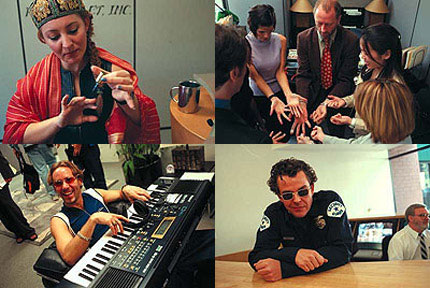4-Screened Madness


As I watched Timecode, the most obvious thing that came to mind was the 4 split screens and their synchronization. I was simply astonished to see how well they were able to interlace each story so that it all happened at the same time. This clearly took a good amount of practice to accomplish. I came home and searched for some information regarding this film and found that they had filmed it like 12 times and they chose the best take. Talk about commitment. This film probably could be watched several times while focusing on only one camera shot. The experience will be different each time. It was quite overwhelming just trying to keep up with all four screens, but it proved to be rather effective and entertaining for this film.
Another thing that came to mind was the use of the DV camcorder. I've used DV camcorders quite a bit and they are quite a different breed when compared to conventional videocassette/film reel cameras. For those that never have used a DV camera, it bascially records still on a tape-like media, but it can easily able to be converted into a digital format. The image from a digital video is rather quite different when compared to film. Just take a look at the picture on the left and compare it to the video of Timecode. There is a certain crispness and temperature that is unique to each type of media. Digital video can indeed be altered to look similar to the film, but I don't believe that it can replace the certain features that film media has.
It was interesting to see the character in the film, the Russian woman, I forgot her name, begin to comment on the types of new media. It seems as if she was speaking for the director, making justifications for using digital video over traditional film. Although I did not quite remember everything she said, I believe she mentioned that the film montage gives us a fake reality and that digital video gives us a new experience. In a sense, she is correct. From the images of film alone, you know that it is a movie, and can distinguish it quite readily. This then does feel like an alternate reality, a "fake" one if you insist. With the digital video, it definitely gave a "reality" to the work. This "reality" is then intensified with the use of rapid camera movie and free flowing filming. It gives us a 1st person view, and it makes it seem as if we are right in the mix with the characters. This new technology did infact give us a new "technological influence" as the Russian woman said.
Labels: felix

0 Comments:
Post a Comment
Subscribe to Post Comments [Atom]
<< Home